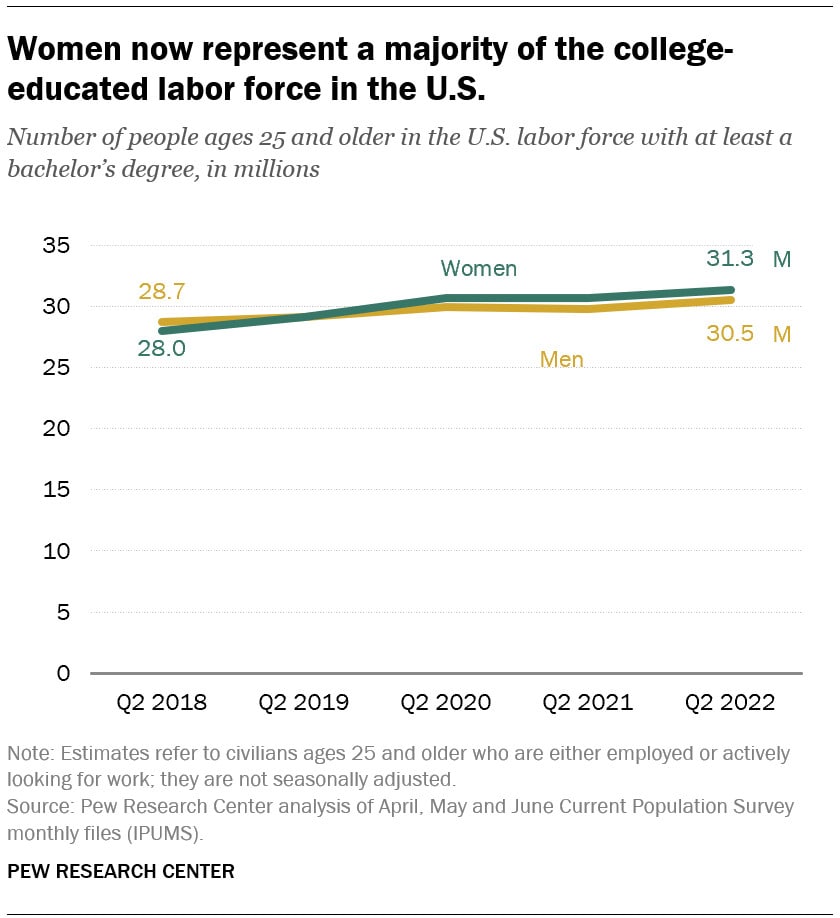Women now account for the majority of the college-educated labour force in the US

Women now account for over 50% of the college-educated labour force in the United States.
Image: Unsplash/Mimi Thian
Stay up to date:
Education, Gender and Work
- Women now account for more than half of the college-educated labour force in the United States, according to Pew Research Center.
- There are 2.2 million more women aged 25 and older with at least a bachelor’s degree in the US labour force than before the pandemic.
- But the COVID-19 pandemic disproportionately impacted labour market activity for adults without a bachelor’s degree, especially among women.
- So, while women have increased their representation in the college-educated labour force since 2019, there has not been much change in the gender composition of the labour force that has some college education or less.
Women have overtaken men and now account for more than half (50.7%) of the college-educated labor force in the United States, according to a Pew Research Center analysis of government data. The change occurred in the fourth quarter of 2019 and remains the case today, even though the COVID-19 pandemic resulted in a sharp recession and an overall decline in the size of the nation’s labor force.

Today, there are more women ages 25 and older with a bachelor’s degree or more education in the labor force than before the pandemic: 31.3 million in the second quarter of 2022, compared with 29.1 million in the same quarter of 2019. The number of college-educated men ages 25 and older in the labor force is also greater than before the pandemic – 30.5 million, up from 29.1 million – though their ranks have not increased as quickly as those of women.
The pandemic disproportionately impacted labor market activity for adults without a bachelor’s degree, especially among women. The number of women with some college or less education in the labor force has declined 4.6% since the second quarter of 2019, compared with a smaller change among men with some college or less education (-1.3%).

The upshot of these disparate changes in the labor force by gender and education is that women have increased their representation in the college-educated labor force since 2019. At the same time, there has not been much change in the gender composition of the labor force that has some college or less education.
Changes in the composition of the U.S. population, along with changes in labor force participation, help account for these trends. The number of women and men in the labor force depends on the size of each group and the percent of that group who are working or seeking work.
How is the World Economic Forum promoting equity in the workplace?
The number of women and men in the U.S. with at least a bachelor’s degree has increased since the second quarter of 2019. But the share of college-educated women who are in the labor force has not changed since before the pandemic, while the share of college-educated men who are working or looking for work has declined.

In the second quarter of 2022, the labor force participation rate for college-educated women was 69.6%, the same as in the second quarter of 2019. In contrast, men and most other educational groups now have lower rates of labor force participation than they did in the second quarter of 2019.
This shift in the college-educated labor force – as women now comprise a majority – comes around four decades after women surpassed men in the number of Americans earning a bachelor’s degree each year.
Accept our marketing cookies to access this content.
These cookies are currently disabled in your browser.
Don't miss any update on this topic
Create a free account and access your personalized content collection with our latest publications and analyses.
License and Republishing
World Economic Forum articles may be republished in accordance with the Creative Commons Attribution-NonCommercial-NoDerivatives 4.0 International Public License, and in accordance with our Terms of Use.
The views expressed in this article are those of the author alone and not the World Economic Forum.
Forum Stories newsletter
Bringing you weekly curated insights and analysis on the global issues that matter.
More on Jobs and the Future of WorkSee all
Spencer Feingold
April 15, 2025
Jarah Euston and Isabelle Leliaert
April 10, 2025
Kiva Allgood and Sue Ellspermann
April 9, 2025
Keith E. Ferrazzi
April 7, 2025
Sue Duke
April 4, 2025





